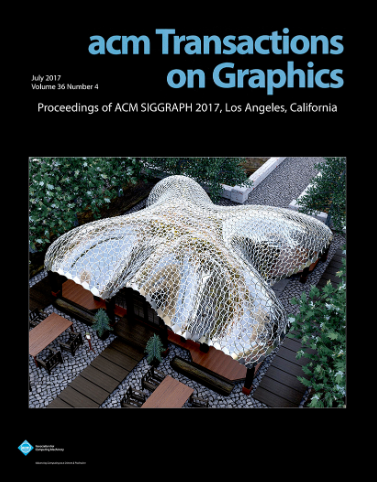设计具有可控粗糙度的三角形网格
IF 9.5
1区 计算机科学
Q1 COMPUTER SCIENCE, SOFTWARE ENGINEERING
引用次数: 0
摘要
受粗糙表面出现在各个设计领域的启发,我们研究了具有可控粗糙度的三角形网格的计算设计。我们的重点是小粗糙度。在这种情况下,粗糙度或光滑度主要是通过网格边缘和网格面相对于参考曲面曲率行为的局部定位产生的。二维对偶图简化了曲率和粗糙度之间的相互作用分析,并在所谓的各向同性几何中生成,这可以看作是欧几里得几何的结构保留简化。网格的各向同性二面角接近欧几里得角,在对偶图中显示为欧几里得边长,这也是可视化和交互式局部设计的工具。我们提出的计算框架包括外观感知重网格化、基于优化的自动粗化和二面角控制。本文章由计算机程序翻译,如有差异,请以英文原文为准。
Designing triangle meshes with controlled roughness
Motivated by the emergence of rough surfaces in various areas of design, we address the computational design of triangle meshes with controlled roughness. Our focus lies on small levels of roughness. There, roughness or smoothness mainly arises through the local positioning of the mesh edges and faces with respect to the curvature behavior of the reference surface. The analysis of this interaction between curvature and roughness is simplified by a 2D dual diagram and its generation within so-called isotropic geometry, which may be seen as a structure-preserving simplification of Euclidean geometry. Isotropic dihedral angles of the mesh are close to the Euclidean angles and appear as Euclidean edge lengths in the dual diagram, which also serves as a tool for visualization and interactive local design. We present a computational framework that includes appearance-aware remeshing, optimization-based automatic roughening, and control of dihedral angles.
求助全文
通过发布文献求助,成功后即可免费获取论文全文。
去求助
来源期刊

ACM Transactions on Graphics
工程技术-计算机:软件工程
CiteScore
14.30
自引率
25.80%
发文量
193
审稿时长
12 months
期刊介绍:
ACM Transactions on Graphics (TOG) is a peer-reviewed scientific journal that aims to disseminate the latest findings of note in the field of computer graphics. It has been published since 1982 by the Association for Computing Machinery. Starting in 2003, all papers accepted for presentation at the annual SIGGRAPH conference are printed in a special summer issue of the journal.
 求助内容:
求助内容: 应助结果提醒方式:
应助结果提醒方式:


